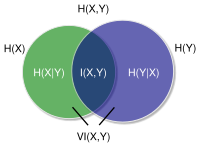Variation of information

Okay kiddo, so let me explain what variation of information means. Let's say you have a toy box and you like to play with different toys inside it. You have two friends, Sam and Sara, who also have toy boxes with different toys in them.
When you compare your toy box with Sam's toy box, you might notice that you both have some of the same toys and some different ones. This is called overlap. The same thing happens when you compare your toy box with Sara's toy box – some toys are the same and some are different.
Variation of information is kind of like measuring how similar or how different your toy box is from someone else's toy box. It takes into account the overlap (same toys) and the differences (different toys) between the two toy boxes.
Sometimes, you might only care about certain toys that are in both toy boxes. For example, if you both have a toy car, you might only want to compare those two toys. Other times, you might want to compare all the toys in the toy boxes. This is what variation of information is doing – it's measuring how much overlap and how much difference there is between all the toys in the toy boxes.
So, variation of information is a way to measure how similar or different two things are by looking at all of their parts and figuring out what they have in common and what's different. It's like comparing toy boxes – you can decide which toys are the same and which are different, and see how similar or different the toy boxes are overall.
When you compare your toy box with Sam's toy box, you might notice that you both have some of the same toys and some different ones. This is called overlap. The same thing happens when you compare your toy box with Sara's toy box – some toys are the same and some are different.
Variation of information is kind of like measuring how similar or how different your toy box is from someone else's toy box. It takes into account the overlap (same toys) and the differences (different toys) between the two toy boxes.
Sometimes, you might only care about certain toys that are in both toy boxes. For example, if you both have a toy car, you might only want to compare those two toys. Other times, you might want to compare all the toys in the toy boxes. This is what variation of information is doing – it's measuring how much overlap and how much difference there is between all the toys in the toy boxes.
So, variation of information is a way to measure how similar or different two things are by looking at all of their parts and figuring out what they have in common and what's different. It's like comparing toy boxes – you can decide which toys are the same and which are different, and see how similar or different the toy boxes are overall.
